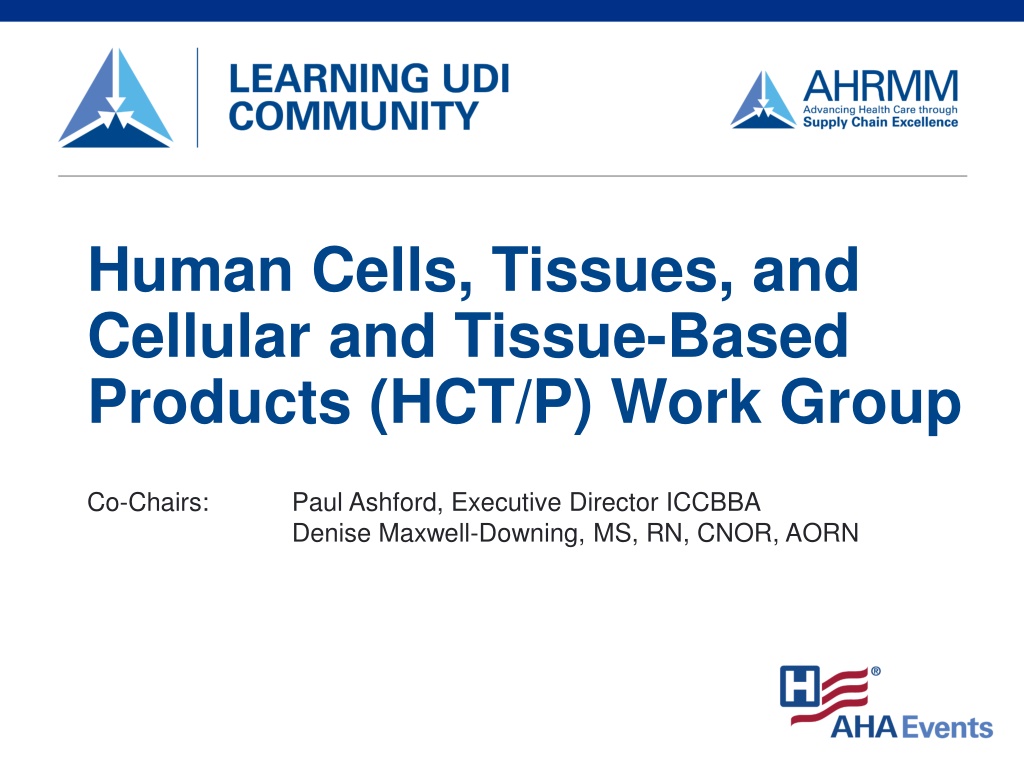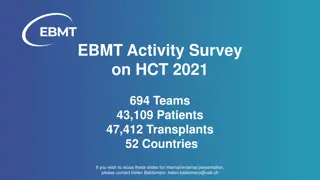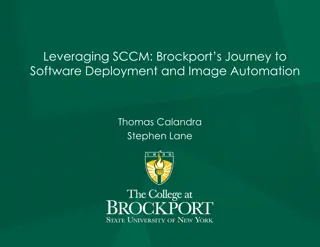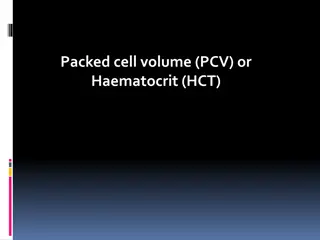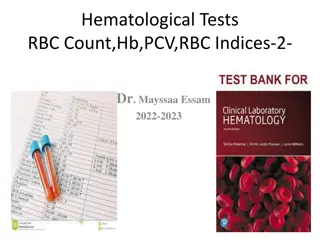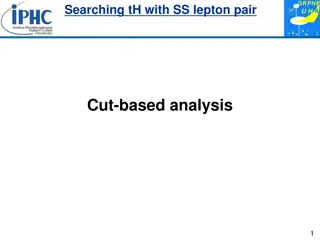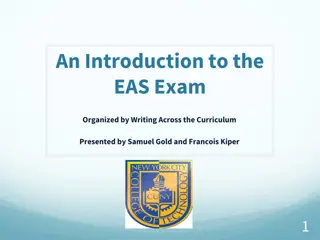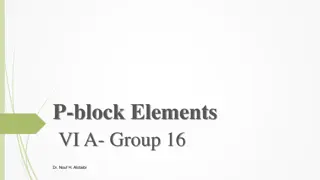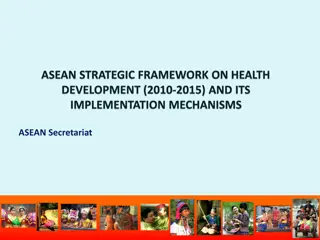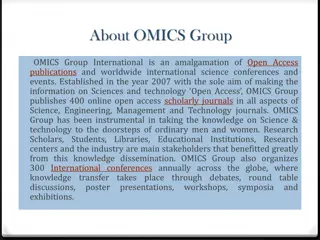The Role of the HCT/P Work Group in Educating the UDI Community
The LUC Human Cells, Tissue, and Cellular and Tissue-based Products (HCT/P) work group, led by co-chairs Paul Ashford and Denise Maxwell-Downing, aims to develop educational materials and guidance documents regarding the tracking of medical devices containing HCT/Ps. This group consists of stakeholders from various parts of the supply chain to address the unique management needs of HCT/Ps, emphasizing traceability between donors and recipients for efficient product recall. The importance of harmonization across HCT/P products, distinct identification codes, and compliance with Health IT certification criteria are key focal points of the group's educational efforts.
Download Presentation

Please find below an Image/Link to download the presentation.
The content on the website is provided AS IS for your information and personal use only. It may not be sold, licensed, or shared on other websites without obtaining consent from the author. Download presentation by click this link. If you encounter any issues during the download, it is possible that the publisher has removed the file from their server.
E N D
Presentation Transcript
Human Cells, Tissues, and Cellular and Tissue-Based Products (HCT/P) Work Group Co-Chairs: Paul Ashford, Executive Director ICCBBA Denise Maxwell-Downing, MS, RN, CNOR, AORN
Work Group Members Name Organization Name Organization Co-chair LUC HCT/P Workgroup Executive Director ICCBBA, Co-chair LUC HCT/P Workgroup InformaticsNurse, AORN Paul Ashford Courtney Gorgone Geisinger Health System Denise Downing Larry Gossman Eskenazi Health Shiva Arjunon MiMedx Lisa Graney LifeNet Health Hans J. Buitendijk Cerner Corporation Department of Veterans Affairs, Sustainment of Blood Bank Maintenance Team Becky Holman DCI Donor Services Tissue Bank Mohamed Harunani Midwest Dental Karen Burns Cassandra D. Josephson Emory University Greg Bylo GS1 Katherine Kavlock FDA Esther Carbon RTI Surgical, Inc. Grace Y. Kim FDA Peter Casady Champion Healthcare Technologies Allison Mehr HBICC Shana Christrup Hart Health Strategies Department of Veterans Affairs, P&LMS Program Office Valerie Miller Jay Crowley USDM Life Sciences Monica Freire ICCBBA Behnaz Minaei FDA
Work Group Members Name Organization Christopher Talbot Medtronic Quynh Vantu Department of Veteran Affairs Porcia Moses Alameda Health System Mike Nolan Automatic Identification Systems, Inc. The Franciscan Missionaries of Our Lady Health System James Phillips Shirley L. Ransome Texas Children's Bill Reese Geisinger Health System Jean Sargent USDM Mike Schiller Senior Director, Supply Chain, AHRMM
Purpose The LUC Human Cells, Tissue, and Cellular and Tissue-based Products (HCT/P) work group will develop educational materials and guidance documents to address tracking of medical devices containing HCT/Ps. Representatives of the group are stakeholders from all parts of the supply chain, including providers.
The HCT/P work group will help to educate the UDI community about: The unique characteristics of HCT/P that necessitate that they be managed differently than other medical devices; The need for traceability between donor and recipient as an essential tracking requirement for HCT/P in order to support rapid donor specific product recall on a national and international basis; The need to ensure harmonization of track and trace across all HCT/P products whether regulated as medical devices or biologic; The role of the distinct identification code production identifier that is required for devices containing HCT/P; and, The need for the distinct identification code to be parsed from the UDI to meet 2015 edition Health IT certification criteria.
Background Human cells, tissues, and cellular and tissue-based products (HCT/P) are widely used in healthcare. Most of these products are regulated as biologics, but some products fall within the scope of medical devices. HCT/Ps have unique characteristics that are not present for other healthcare products.
What is an HCT/Ps? Human cells, tissues, and cellular and tissue-based products (HCT/Ps) are articles containing or consisting of human cells or tissues that are intended for implantation, transplantation, infusion, or transfer into a human recipient.
Important HCT/Ps Information A single donor can be the source of many different products, for example, one donor may donate skin, tendons, heart valves, and a wide range of bone products. All of these different products share a common history. Some of the products prepared from one donor may fall within biologics regulation while other products from the same donor fall within medical device regulation. HCT/P carry a risk of disease transmission. While this risk is minimized by testing and processing, it can never be entirely eliminated.
HCT/Ps Examples Bone Ligament Skin Cornea Dura Mater Heart Valves Sperm, oocyte, embryo Hematopoietic stem/progenitor cells Other cellular therapies (e.g. Mesenchymal Stromal Cells, Dendritic cells)
Non-HCT/Ps Examples Vascularized human organs Whole blood or blood components Secreted or extracted human products (e.g., milk, collagen), except semen Minimally manipulated bone marrow for homologous use Cells, tissue, organs derived from animals Invitro diagnostic products
HCT/Ps Regulations FDA 21 CFR Part 1270 (Human Tissue Intended for Transplantation) Part 1271 (Human Cells, Tissues and Cellular and Tissue- Based Products) Subpart D 1271.290 (Tracking) Part 803 (Medical Device Reporting) Part 821 (Medical Device Tracking Requirements) Part 830 (Unique Device Identification [UDI])
FDA 21 CFR Part 1271.20 If you are an establishment that manufactures an HCT/P that does not meet the criteria set out in 1271.10(a), and you do not qualify for any of the exceptions in 1271.15, your HCT/P will be regulated as a drug, device, and/or biological product under the act and/or section 351 of the PHS Act, and applicable regulations in title 21, chapter I. Applicable regulations include, but are not limited to, 207.20(f), 210.1(c), 210.2, 211.1(b), 807.20(d), and 820.1(a) of this chapter, which require you to follow the procedures in subparts B, C, and D of this part. https://www.accessdata.fda.gov/scripts/cdrh/cfdocs/cfcfr/CFRSearch.cfm?fr=1271.20
FDA 21 CFR Subpart D Current Good Tissue Practice Section 1271.290 Tracking (c) Distinct identification code. As part of your tracking system, you must ensure: That each HCT/P that you manufacture is assigned and labeled with a distinct identification code, e.g., alphanumeric, that relates the HCT/P to the donor and to all records pertaining to the HCT/P; and that labeling includes information designed to facilitate effective tracking, using the distinct identification code, from the donor to the recipient and from the recipient to the donor. https://www.gpo.gov/fdsys/search/pagedetails.action?collectionCode=CFR&browsePath=Title+21%2FChapter+I%2FSubchapter+L%2FPart+1271%2FS ubpart+D%2FSection+1271.290&granuleId=CFR-2010-title21-vol8-sec1271-290&packageId=CFR-2010-title21-vol8&collapse=true&fromBrowse=true
FDA UDI Rule FDA established the UDI Rule in Sept. 24, 2013 The UDI rule outlines labeling, data submission, and standard date formatting requirements for all medical devices in distribution and use in the US, unless an exception or alternative applies Device labelers (manufacturers) must submit certain information about each device to the FDA s Global Unique Device Identification Database (GUDID)
FDA UDI Rule Labelling Requirements: UDI will be supplied in a human- and machine-readable format PI can consist of expiration date, lot number and serial number. DI PI A unique alphanumeric or numeric code Consists of the device identifier (DI) and production information (PI)
FDA UDI Labeling Requirements DI is a mandatory, fixed portion of the UDI that identifies the labeler and the specific version or model of the device PI is a conditional, variable portion of the UDI that identifies: the lot or batch number when manufactured; the serial number of the device; the expiration date of the device; the date (yyyymmdd) the device was manufactured; and the distinct identification code required by 1271.290(c) for a human cell, tissue, or cellular and tissue-based product (HCT/P) regulated as a device
FDA UDI Label Issuing Agencies GS1 (Global Standards One) HIBCC (Health Industry Business Communication Council) ICCBBA (International Council for Commonality in Blood Banking Automation)
FDA GUDID The Global Unique Device Identification Database (GUDID) is a database administered by the FDA that will serve as a reference catalog for every medical device with an identifier. The labeler of each medical device must submit information to the GUDID by their devices compliance timeline The public can access information contained in the GUDID through AccessGUDID
UDI and EHRs 2015 Edition Health Information Technology Certification Criteria specifies that Health IT must be able to electronically perform a number of capabilities including recording and parsing the unique device identifiers associated with a patient s implantable device, and enabling a user to access the identifiers associated with the UDI (45 CFR 170.315)
EHRs to include UDI EHR 2015 certification Implantable Device List: Record Unique Device Identifiers associated with a patient s Implantable Devices. Parse the following identifiers from a Unique Device Identifier: Device Identifier; The following identifiers that compose the Production Identifier: The lot or batch within which a device was manufactured; The serial number of a specific device; The expiration date of a specific device; The date a specific device was manufactured; and For an HCT/P regulated as a device, the distinct identification code required by 21 CFR 1271.290(c). Enable a user to access the identifiers listed above.
UDI, HCT/Ps and EHRs Certified EHRs must be able to electronically capture, store, and parse a medical devices UDI (DI & PI) from the issuing agency s specifications. The medical device that contains an HCT/Ps will need the distinct identification code (DIC) parsed from the UDI. The parsing of the DIC is what makes a medical device containing an HCT/Ps different from other medical devices.
FDA UDI Label Issuing Agencies GS1 (Global Standards One) HIBCC (Health Industry Business Communication Council) ICCBBA (International Council for Commonality in Blood Banking Automation)
FDA UDI Label Issuing Agencies GS1 GS1 utilizes a system of standards which includes a Global Trade Identification Number (GTIN) and Application Identifiers (AIs) to appropriately identify and describe a product. GS1 recommend that the Device Identifier (DI) and the Production Identifier (PI) are used in their entirety for an HCT/P product.
FDA UDI Label Issuing Agencies GS1 The UDI Device Identifier (DI) is the Global Trade Identification Number (GTIN). The Production Identifiers (GS1s AIs) which pertain to the GS1 standard are as follows: (10) Lot/Batch a 20 character alphanumeric field (17) Expiry Date YYMMDD (21) Serial Number - a 20 character alphanumeric field (11) Production Date YYMMDD GS1 recommends that manufacturers/processors of HCT/Ps using GS1 standards, utilize the Serial number (AI 21 field) to encode the DIC. This is a variable length 20 character alphanumeric field and provides the capability to encode an alphanumeric DIC as needed and in accordance with Part 1271.290(c). If the manufacturers/processors of HCT/Ps utilizing GS1 standards do not use the recommended serial number as the DIC. The DIC may be the lot number or a combination of serial/lot number. Healthcare organizations will need to verify the data being used with the manufacturer/processor.
GS1 The components of the GS1 data matrix are as follows: (01) Global Trade Item Number (GTIN) unique to a single item type/ Product code/SKU (17) Expiration date (21) Serial number - distinct identification code unique to a single donor (10) Batch or lot number unique to a single graft but is not used in this example The GTIN plus a serial number based Distinct Identification Code constitutes a unique graft identifier (recognized globally).
HIBCC The HIBCC Standard does not provide a specific production identifier for the distinct identification code. Labelers are permitted by FDA to use a serial number, lot number, or combination of serial and lot number as a distinct identification code. The identifiers fulfilling the role of the distinct identification code will vary between labelers.
HIBCC Healthcare organizations will need to maintain a reference table on their systems that identifies for each DI, the appropriate production identifiers to be parsed to obtain the distinct identification code. The information will need to be obtained directly from the labeler. To ensure uniqueness, the distinct identification code will need to be associated with the labeler identity.
HIBCC Linear Concatenated Barcode
HIBCC Linear Non-concatenated Barcode
ICCBBA Uses the ISBT 128 Standard where the distinct identification code is specified as the donation identification number (DIC). The DIC can be parsed directly from the medical device s production identifier and will always be present. The DIC is globally unique, maps to a unique donor worldwide, and is compliant with ISO/IEC 15459-3.
